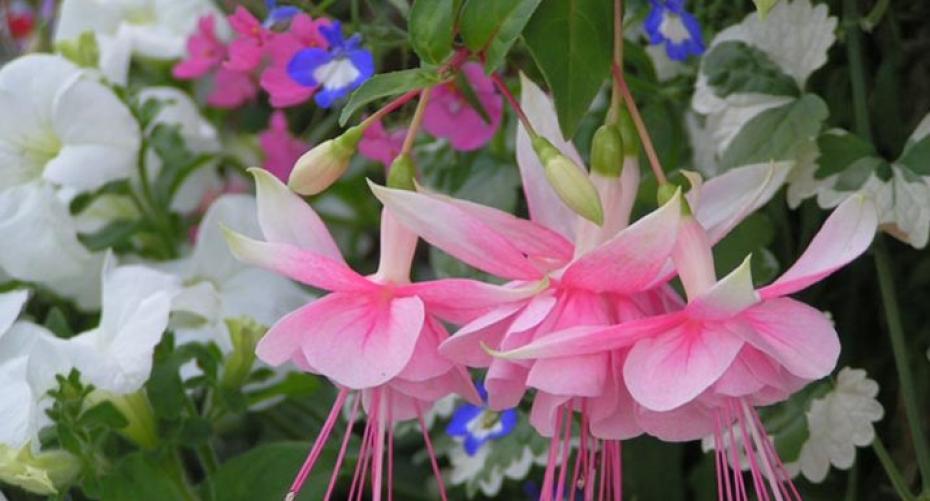Fuchsia with nepeta, lobelia, calibrachoa and petunias
Follow our hints and tips for a spectacular show of summer bedding
Planting
- Bedding plants are hungry and thirsty as they pack a lot into a short space of time, so incorporate a slow release fertiliser and water retention gel into the compost.
- Use a specific container and basket compost which already contains fertiliser and water retention gel.
- If planting a large tall container fill the bottom with polystyrene to within 30cm (12”) of the rim, to cut down on the amount of compost needed. If you live in an area where theft could be a problem substitute the polystyrene for bricks.
- Make sure there are plenty of drainage holes in the container; bedding likes to be damp not sodden, otherwise they will rot.
- Pack in the plants, if you are too skimpy it will take a while for the container to look full and lush.
- Go for 3 layers of plants both for containers and hanging baskets; a tall upright for the centre, smaller upright plants surrounding the central one and trailers to go over the edge.
- If the container is going against a wall or on a windowsill place the tall plants at the back.
- Don’t worry about a colour scheme, when it comes to summer bedding anything goes.
- Summer bedding plants need full sun.
- Busy Lizzies (Impatiens) are good for a shady spot but recently have been decimated by downy mildew so you can plant New Guinea impatiens instead. The downside is the New Guineas have more leaf area and less flowers then the Busy Lizzies.
- If you have had Busy Lizzies with the downy mildew in your garden don’t plant them again for at least 7 years as the mildew lays dormant and could re-surface. Some suppliers are starting to stock them again, using certified mildew-free stock.
- Keep the cost down and pad out the container with cheaper multi-pack bedding such as lobelia and just add a few more expensive plants sold in single pots.
- Sowing seed in late winter/early spring will also keep the cost down if you have a lot of containers.
- Plug plants and seedlings bought in late winter can also keep the cost down; they need to be potted on and grown in a warm light environment until they are ready to go outside.

Trailing begonia
Aftercare
- Feed weekly with a potash based fertiliser such as Tomorite to promote flower production.
- If you have incorporated slow release fertiliser into the compost, feed with Tomorite at the end of summer to keep the show going into autumn when the winter bedding should be appearing in garden centres.
- Keep deadheading, at least twice a week. If you leave the spent flower heads the plant thinks its job of producing seed is done and will stop producing any more flowers.
- When you first buy the plants they may be a bit leggy so pinch out the growing tips to encourage them to bush out and produce side shoots. A bushier plant will produce more flowers.
- Over-winter the more expensive plants, such as geraniums and fuchsias in the spare bedroom; they just need to be frost free with very little water.
- If you have several containers and hanging baskets consider investing in a self-watering system on a timer, such as those from Hozelock, then you are assured that they won’t dry out.
- If you plant out your bedding before all danger of frosts has passed, usually the beginning of June here in the Lake District, be ready to cover them with horticultural fleece or an old net curtain if frost is forecast.

Pelergonium Aldwyck
Problems
- Mildew can be a problem and it’s caused by the plant being dry and stressed so make sure the container is always watered and fed. There are fungicidal sprays but once you have mildew it is difficult to eradicate, so spray at the very first signs.
- Slugs and snails can be problem with containers on the ground so stand the pots on sharp gravel, place a copper band around the pot, use wildlife and pet friendly slug pellets or go out at night with a torch and pick them off.

Osteospermum Sunshine Beauty
Varieties
- Colour combinations: pink, purple and white; red, orange and yellow; red, purple and blue; purple, orange and cream; white, yellow and blue.
- Keep it simple with just geraniums and nepeta together, calandulas and Lysimachia nummularia ‘Aurea’ or just trailing begonias ‘Illumination’ series.
- Add some trailing foliage to rest the eye from all the busyness of the flowers: Nepeta (soft, long, variegated); Helichrysum (stiff, more horizontal than trailing, silver or gold); Lysimachia nummularia ‘Aurea’ (soft, gold, evergreen).
Remember to keep your summer bedding plants looking great well into autumn by keeping watered, fed and most importantly deadheaded. If the plants start to set seed they stop producing any more flowers.


